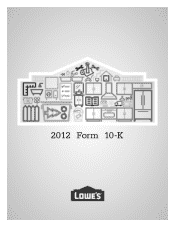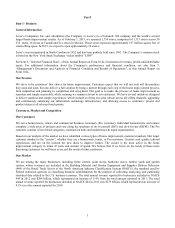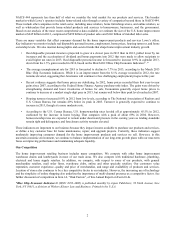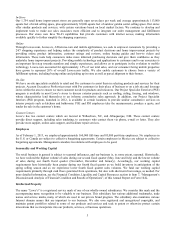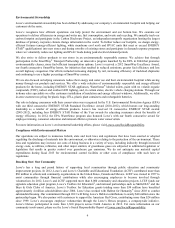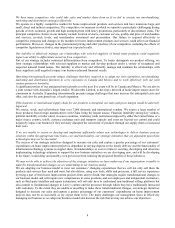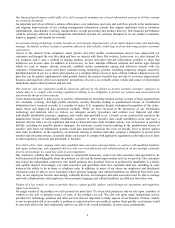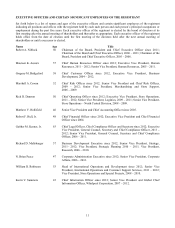Lowe's 2012 Annual Report Download - page 16
Download and view the complete annual report
Please find page 16 of the 2012 Lowe's annual report below. You can navigate through the pages in the report by either clicking on the pages listed below, or by using the keyword search tool below to find specific information within the annual report.2
NAICS 444 represents less than half of what we consider the total market for our products and services. The broader
market in which Lowe’s operates includes home-related sales through a variety of companies beyond those in NAICS 444.
These include other companies in the retail sector, including mass retailers, home furnishings stores, and online retailers, as
well as wholesalers that provide home-related products and services to homeowners, businesses, and the government.
Based on our analysis of the most recent comprehensive data available, we estimate the size of the U.S. home improvement
market at $645 billion in 2012, comprised of $499 billion of product sales and $146 billion of installed labor sales.
There are many variables that affect consumer demand for the home improvement products and services Lowe’s offers.
Key indicators we monitor include real disposable personal income, employment, home prices, housing turnover, and home
ownership levels. We also monitor demographic and societal trends that shape home improvement industry growth.
• Real disposable personal income is projected to grow at a slower pace in 2013 than in 2012, pulled lower by tax
increases and the acceleration of dividend and bonus payments into 2012 that were made to allow recipients to
avoid higher tax rates in 2013. Real disposable personal income is forecasted to increase 0.9% in calendar 2013,
down from the 1.5% gain recorded in 2012, based on the March 2013 Blue Chip Economic Indicators®. *
• The average unemployment rate for 2013 is forecasted to decline to 7.7% in 2013, according to the March 2013
Blue Chip Economic Indicators. While it is an improvement from the 8.1% average recorded in 2012, the rate
remains elevated, suggesting that Americans will continue to face challenging employment prospects this year.
• Recent evidence suggests that home prices are stabilizing. In 2012, home prices recorded their first year-to-year
gains since 2007, according to the Federal Home Finance Agency purchase-only index. The gains were driven by
strengthening demand and lower inventories of homes for sale. Economists generally expect home prices to
continue to increase at a modest single-digit pace in 2013, but remain well below their peak level reached in 2007.
• Housing turnover increased 8.9% in 2012 from low levels, according to The National Association of Realtors and
U.S. Census Bureau, but remains 40% below its peak in 2005. Turnover is generally expected to continue to
increase in 2013, though at a more moderate rate.
• According to the U.S. Census Bureau, U.S. homeownership rates leveled off at approximately 65.5% in 2012,
cushioned by the increase in home buying. That compares with a peak of about 69% in 2004. However,
homeownership rates are expected to remain under downward pressure in the coming years as lending standards
remain tight and delinquency and foreclosure activity remains elevated.
These indicators are important to our business because they impact income available to purchase our products and services,
or define a key customer base for home maintenance, repair, and upgrade projects. Currently, these indicators suggest
moderately improving consumer demand for the home improvement products and services we sell. However, in this
uncertain economic environment, we continue to balance implementation of our long-term growth plans with our near-term
focus on improving performance and maintaining adequate liquidity.
Our Competition
The home improvement retailing business includes many competitors. We compete with other home improvement
warehouse chains and lumberyards in most of our trade areas. We also compete with traditional hardware, plumbing,
electrical and home supply retailers. In addition, we compete, with respect to some of our products, with general
merchandise retailers, mail order firms, warehouse clubs, online and other specialty retailers. Our customers value
reputation, customer experience, quality and price of merchandise, and range and availability of products and services.
Location of stores also continues to be a key competitive factor in our industry. However, the increasing use of technology
and the simplicity of online shopping also underline the importance of multi-channel presence as a competitive factor. See
further discussion of competition in Item 1A, “Risk Factors”, of this Annual Report on Form 10-K.
*Blue Chip Economic Indicators® (ISSN: 0193-4600) is published monthly by Aspen Publishers, 76 Ninth Avenue, New
York, NY 10011, a division of Wolters Kluwer Law and Business. Printed in the U.S.A.








